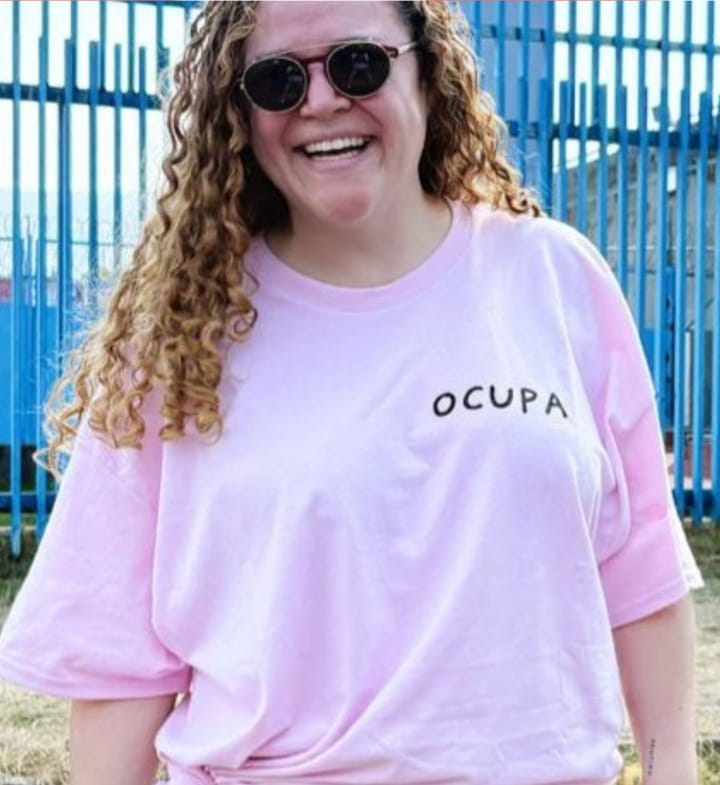Por Montserrat Jiménez Valero

Llegamos a punto de las 10 a.m. La entrada, como siempre, era compleja y poco coordinada. Los oficiales estaban ensimismados, ese cotito de poder que se les escurría entre los dedos con cada nuevo visitante. ¿Sabrán que vamos a ayudar? ¿Entenderán que nuestro trabajo es voluntario, que no hay otro interés más que llevar un respiro de humanidad a este encierro?
¡Ocupa! (Organización Comunitaria por la Paz) lleva cuatro años recorriendo los pasillos grises de Santa Martha, Oriente, Acapulco, Tlaxcala, Nuevo León; y así la historia empezó por los rincones federales y estatales. Cuatro años de risas compartidas, de baile con los pies encadenados a un destino incierto, de historias que se susurran entre notas de cumbia. Y aquí estamos otra vez, en Tepepan, para hacerlas bailar, para recordarles que aún pueden vivir. Pero aquí hay algo distinto, algo que pesa en el aire. Un déficit espantoso. Un exceso de medicación administrada sin sentido, sin nombre, sin razón.
Las mujeres aquí están divididas. Dos pabellones, dos realidades. Algunas, más conscientes, aunque igual de medicadas, cargan en los ojos una historia de lucha interna. Otras deambulan, moviendo las caderas con una calma irreal, como si flotaran en una realidad distorsionada, como si el tiempo se hubiera detenido para ellas. Rosaura, Fer, Lety, Marquita, Susana... Nombres que se van entrelazando en medio de la música, de los giros de un baile que las devuelve, aunque sea por unos minutos, a lo que fueron antes de las rejas.
A mí no me interesa juzgar, nunca me ha interesado. No vine a preguntar por crímenes o culpas, vine a darles un respiro, una pausa, una chispa de algo distinto a la rutina impuesta. Pero no puedo evitar preguntarme: ¿qué tipo de penal es este que anestesia la existencia de mujeres que ni siquiera tienen sentencia?, ¿cómo puede un sistema apagar así las voces de quienes aún esperan un destino?
Dosis altas de pregabalina. La mayoría lo toma; combinando antipsicóticos benzodiacepinas y antidepresivos, dado que no está personalizado ningún tratamiento, las dosis que toman son incorrectas. ¿La sedación olvida la tristeza?
Aún así, entonces, la magia sucede. Se vuelve un loop de emoción perdida y desbordada. Se parece a San Bernardino, pero aquí la desesperanza es más espesa, más tangible. La salsa empieza a sonar fuerte, retumbando contra las paredes frías. Y de pronto, se rompe el miedo. Alguien se anima, una de Ocupa, de Rosita, da el primer paso. Luego otra. El desfile comienza: una a una salen a bailar, a reír, a moverse con una energía que llevaba demasiado tiempo dormida.
Las miradas cautivas de las más tímidas empiezan a encenderse. Algunas cantan, otras se atreven a pedir un palomazo. Hay quienes cierran los ojos, dejándose envolver por el sonido, mientras otras buscan los audífonos del sonidero, queriendo aferrarse a esa pequeña libertad auditiva, como si por un instante el mundo entero fuera solo música y movimiento.
Las oficiales que están ahí resguardando "nuestra seguridad" se dan cuenta de algo inesperado: hemos conectado tanto con ellas que la seguridad es solo un espejismo, un pretexto, meramente un símbolo de poderío. Pero algo cambia. Empiezan a reír. ¡El efecto dominó sucede! La barrera invisible se desvanece. Por un momento, son solo mujeres en un mismo espacio, bailando, sintiendo, existiendo sin etiquetas.
Y entonces me golpea una verdad cruda y dolorosa: las oficiales de seguridad también son presas. Presas de un sistema, de un deber, de una rutina que las consume. ¿Quién cuida de su salud mental? ¿Quién las escucha cuando el peso del encierro también recae sobre sus hombros? Otra lágrima se desliza por mi mejilla. No sé si por ellas, por nosotras o por todas.
Los ejercicios rítmicos seguían, el cuerpo ya no dudaba, se entregaba sin miedo. Enseguida empezó el reguetón, un toque de explosión, una dirección clara a las más "sexys", a las que llevan la música en la piel. El ritmo las convoca, las mueve, las enciende. Y entonces, todas aplauden en círculo, marcando un compás invisible que nos une, un lazo de esperanza en medio del encierro.
—¡Todas somos una! —les dije. Y lo sentí. Por un instante, la realidad de los muros desapareció, y solo quedó la música, la risa, la libertad dentro del cuerpo. Porque mientras se baile, se resista, se sueñe... siempre habrá una forma de ser libre.
Ya casi al finalizar, nuestras manos cubiertas de pintura morada y rosa encontraron su lugar en la pared. Huellas de lucha, de amor, de resistencia. Un grito de libertad estalló en el aire:
—¡Ocupa vive y resiste!
No éramos solo visitantes en ese espacio; éramos parte de algo más grande, un eco de esperanza que se niega a apagarse. Nos rodeamos en un abrazo colectivo, unas diez, entrelazadas en un círculo de fuerza y ternura. Luego nos esparcimos como esporas, sembrándoles la semilla de la esperanza. Porque esa, la verdadera, no muere. Aunque el encierro mate.
*Monserrat Jiménez Valero forma parte de OCUPA (Organización Comunitaria por la Paz), un tejido de resistencia, amor y dignidad que transforma realidades desde la colectividad; Monserrat ha dedicado su vida a llevar arte, música, acompañamiento psicológico y palabra a los rincones más olvidados. Su labor en cárceles, calles y comunidades vulneradas es un faro de solidaridad que reivindica y da voz a quienes han sido desplazadas, violentadas o silenciadas.
Las opiniones expresadas son responsabilidad de sus autoras y son absolutamente independientes a la postura y línea editorial de Opinión 51.






Comments ()